Folks, let me open this piece up by stating plainly that strength matters! Strength is so important that it may be the difference between an independent, active later-adulthood and hiring a home care professional to assist you in bathing and using the toilet. Strength can heavily influence your financial life, your love life, and the legacy you leave for future generations of your family.
Physical strength, in this context, refers to the ability to produce force against an external object or to resist an external force. Force is defined as F = m*a, mass x acceleration. Gravity acting on our bodies is a force.
Strength has multiple permutations that have different names, but stem from the same basic root quality. Endurance is the ability to express strength repeatedly over time. Work is strength applied over a distance. Power is the ability to express strength very quickly. Motor control is strength expressed with accuracy and precision. All of these cousins of pure strength are needed in daily life and if they are cultivated carefully they extend the quality and quantity of our days. Our relative strength, or strength to bodyweight ratio is of most importance, according to a research study published in the European Journal of Preventative Cardiology in 2012.
This 2012 Brazilian research study provides an excellent predictor of quality and quantity of life based on a strength to bodyweight ratio. The study also gives us some clues on how to approach getting strong so that we can live better. The study tested and followed 2002 adults ranging from 51 to 80 years old – measuring the ability to sit down onto the floor and then rise from the floor– Sit and Rise Test (SRT). The participants’ base scores of 5 had a point subtracted for every support limb needed to get up. If they used both knees on the floor as well as one hand, 3 points were subtracted from 5 and their resultant SRT score was 2. The participants were followed for up to 6.3 years. Over that time, 159 participants died. Those that passed away from this earth in that time tended to have lower SRT scores. And every limb NOT used to get up from the floor equated to 21% increase in survival statistically.
Now I bet you’re thinking, “Wow, I feel really bad for those older Brazilian people, but I can get up and down and I’m young enough to not worry about that.” Or you may be thinking, “I hate getting on the floor and I seriously fear falling and being unable to get up on my own.” If you are more like the former, try getting down on the floor now and attempt getting up with no use of hands. Not easy, right? If you’re the latter and a bit scared to try that, keep reading and you’ll see that there are methods to improve your strength to bodyweight ratio and make getting up from the floor much easier.
Enter the Turkish Get Up! This exercise involves the use of your body to get down on the floor and up, and then back down carefully using three support limbs. It is a skill-building practice that requires shoulders and arms to push & pull, the legs to lunge up and down and the trunk to create and resist rotational forces. If I had to choose one exercise to practice for the rest of my life to remain most functional, it is the Turkish Get Up.
This exercise can be broken up into 3 main parts. Part 1 is moving from lying on your back to sitting tall under load of the implement used for resistance. Part 2 involves moving from sitting tall to kneeling. Part 3 requires you to move from kneeling to standing. Then you have to reverse those parts. So we could say that the exercise consists of 6 parts, but that gets to be too confusing. The Turkish Get Up looks like this:
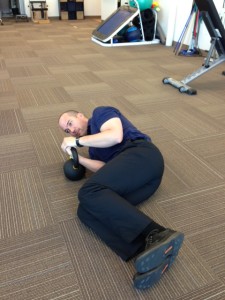 Step 1: Roll to one side in “fetal position” and grab a kettlebell handle with two hands. Then roll to your back.
Step 1: Roll to one side in “fetal position” and grab a kettlebell handle with two hands. Then roll to your back.
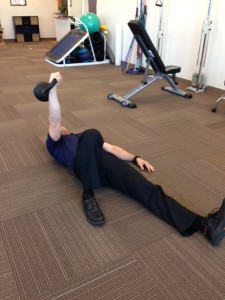 Step 2: Press the kettlebell up with the help of the other hand if needed. Use an active forearm during this movement (flex wrist as if you are in an arm wrestling match).
Step 2: Press the kettlebell up with the help of the other hand if needed. Use an active forearm during this movement (flex wrist as if you are in an arm wrestling match).
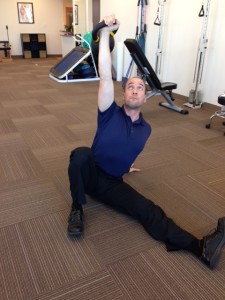 Step 3: Roll to the side, using your bent leg to rotationally “bridge” through the hips and trunk. Lead with your chest and maintain visibility focus on the kettlebell. **This movement is a roll more than a sit-up.**
Step 3: Roll to the side, using your bent leg to rotationally “bridge” through the hips and trunk. Lead with your chest and maintain visibility focus on the kettlebell. **This movement is a roll more than a sit-up.**
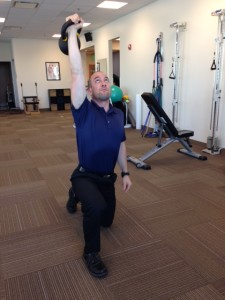 Step 4: Push through the ground with the “down arm” (my Left arm in this photo) and “up leg” (my Right leg in this photo) enough to lift hips about 8 inches off the ground. Then sneak your “down leg” (my Left leg) back behind you to end up in Half-kneeling position as pictured. Maintain visibility on the kettlebell throughout the motion.
Step 4: Push through the ground with the “down arm” (my Left arm in this photo) and “up leg” (my Right leg in this photo) enough to lift hips about 8 inches off the ground. Then sneak your “down leg” (my Left leg) back behind you to end up in Half-kneeling position as pictured. Maintain visibility on the kettlebell throughout the motion.
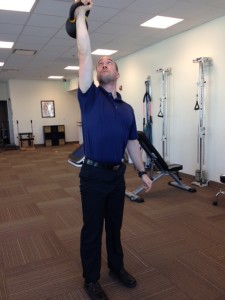 Step 5: Now, from the kneeling position, stand up! Use BOTH legs to push through the ground and to squeeze towards each other. Maintain visibility on the kettlebell. Once you have stood up completely, take a look at the horizon, appreciate the work you did and then return back to the floor in reverse order of what you just performed.
Step 5: Now, from the kneeling position, stand up! Use BOTH legs to push through the ground and to squeeze towards each other. Maintain visibility on the kettlebell. Once you have stood up completely, take a look at the horizon, appreciate the work you did and then return back to the floor in reverse order of what you just performed.
So now you have an initial exposure to the Get-Up as serious tool to get you strong and potentially increase the functional years of your life. To learn more about how to practice the Get-Up and how to organize your practice so that you can progress with it call us at 512-339-1500 to set up an appointment for one-on-one or joint our Symmetry Fitness classes Monday and Wednesday evenings from 5:15-6PM. If you have painful areas restricting you from starting your Get-Up practice you could probably benefit from a PT evaluation to resolve those problems. To get rolling with a PT evaluation all you need is a prescription from your physician that says “PT evaluate and treat”, and call Dawn to set up an appointment.
For interesting reading related to this article:
http://www.strongfirst.com/the-turkish-get-up-a-clinicians-perspective/
http://www.strongfirst.com/the-forgotten-benefits-of-the-turkish-get-up/
Ability to sit and rise from the floor as a predictor of all-cause mortality, European Journal of Preventative Cardiology
